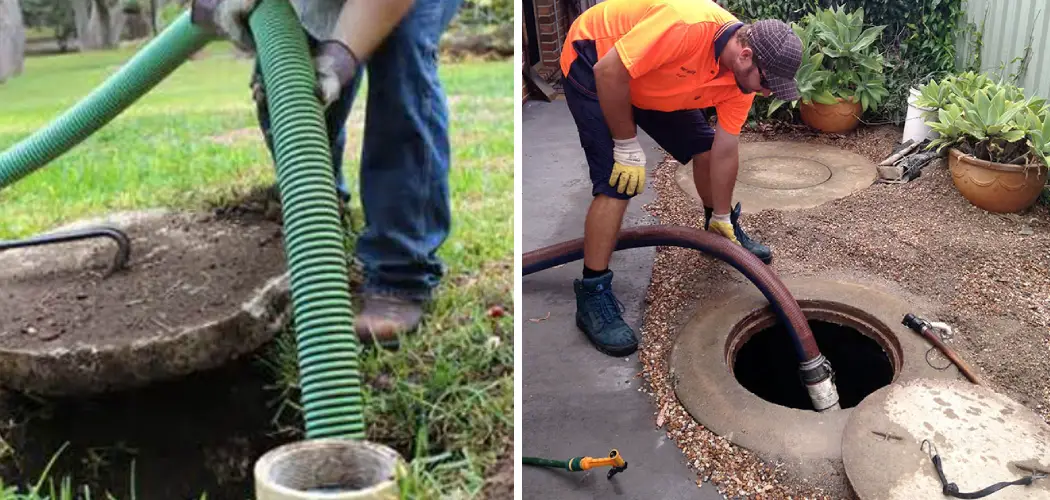A septic tank is an underground wastewater treatment system commonly used in rural areas and homes that are not connected to a public sewer system. It works by separating solid waste from the liquid, allowing bacteria to break down the waste before it is released into a drain field.
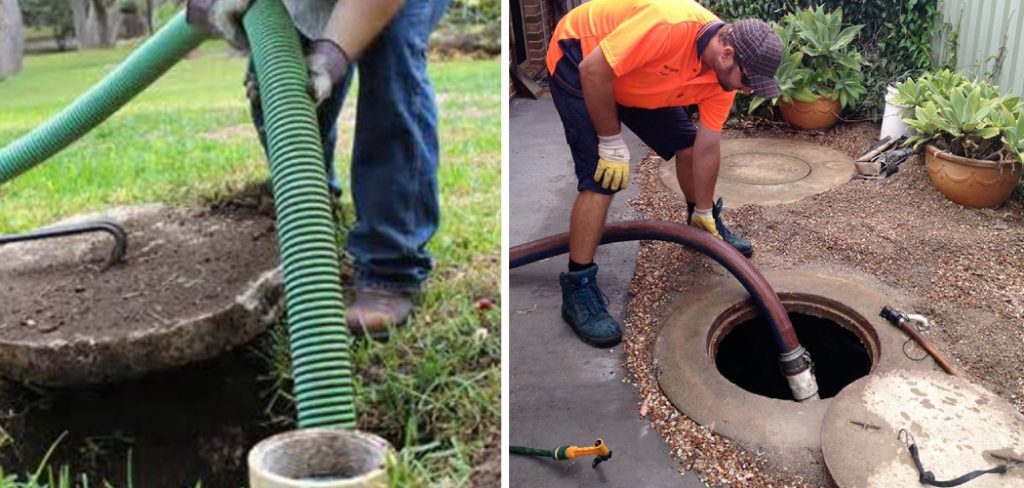
To keep your septic system functioning properly, it is important to pump out the tank regularly. But how do you know when it’s time to pump your septic tank? And what are the steps involved in pumping a septic tank? In this guide, we will walk you through the entire process of how to pump septic tank. So, let’s get started!
Signs That Your Septic Tank Needs to Be Pumped
The frequency with which a septic tank should be pumped depends on various factors, such as the size of the tank, the number of people using it, and the amount of waste produced. On average, a septic tank should be pumped every 3-5 years. However, there are some signs that indicate it may be time to pump your septic tank sooner. These include:
- Slow-draining sinks and toilets
- Foul odors in the area around the septic tank
- Sewage backups in sinks, tubs, or toilets
- Lush patches of grass or vegetation near the drain field
If you notice any of these signs, it’s crucial to schedule a septic tank pumping as soon as possible. Ignoring these signs can lead to costly and messy problems in the future.
Understanding Septic Systems
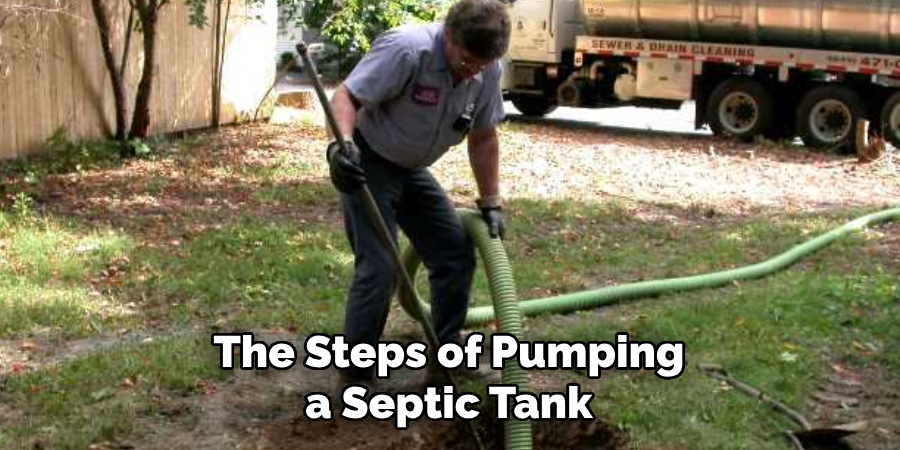
Before we dive into the steps of pumping a septic tank, it’s important to have a basic understanding of how septic systems work. A septic system is made up of three parts: the septic tank, the drain field, and the soil. The wastewater from your household flows into the septic tank, where solids sink to the bottom and oils, and scum float to the top.
Anaerobic bacteria then break down the solid waste. The liquid effluent is released into the drain field, where it is further filtered and treated by the soil. This process continues until the tank is full and needs to be pumped.
Tools and Materials You Will Need to Pump Septic Tank
- A septic truck or vacuum truck
- Shovel
- A hose long enough to reach from the truck to the septic tank
- Protective gear (gloves, goggles, mask)
- Septic tank riser (optional but recommended for easier access to the septic tank)
Step-by-step Guidelines on How to Pump Septic Tank
Step 1: Locate Your Septic Tank
The first step in pumping a septic tank is to locate it. If you have a septic tank riser, this will be much easier as the access point will be above ground level. If not, you may need to dig up the area around the lid or use a metal detector. This step may require some patience and persistence. If you are unable to locate your septic tank, call a professional.
Step 2: Prepare the Tank
Before beginning the pumping process, ensure that all valves and pumps leading to and from the tank are shut off. This will prevent any backup of waste during the pumping process.
Preparing the tank also involves removing debris from the lid and surrounding area, such as roots or rocks. If the lid is covered in dirt or grass, it’s also essential to remove that. This will help prevent contamination during the pumping process.
Step 3: Pump the Tank

Using a septic truck or vacuum truck, the technician will pump out all of the solid waste and liquid from your septic tank. It’s essential to have a long enough hose to reach from the truck to the tank.
Once the pumping is complete, it’s crucial to visually inspect the tank to ensure all waste has been removed. This is where the protective gear comes in handy.
Step 4: Replace and Secure the Lid
After the tank has been pumped, replace and secure the lid back on top. This will prevent any unwanted debris or animals from entering the tank.
If you have a septic tank riser, this step will be much easier as you won’t need to dig up or cover the access point. While replacing the lid, it’s crucial to check for any cracks or damage that may need to be repaired.
Step 5: Clean-Up and Maintenance
Once the pumping process is complete, clean up the area around the septic tank. If there are any spills or leaks during the process, clean them up thoroughly using appropriate disinfectants. It’s also important to keep track of when your septic tank was pumped and any maintenance or repairs done.
This will help you stay on top of the pumping schedule and avoid any potential issues in the future. If you have a septic system, it’s important to regularly maintain and pump your tank to ensure it continues functioning properly.
Following these steps and understanding the signs that indicate it’s time to pump your septic tank will help you maintain a healthy and fully functioning septic system. Remember, if you are unsure or uncomfortable pumping your tank, it’s always best to call a professional for assistance. So, be proactive and keep your septic system in good condition for years to come! Happy pumping!
Additional Tips and Tricks to Pump Septic Tank
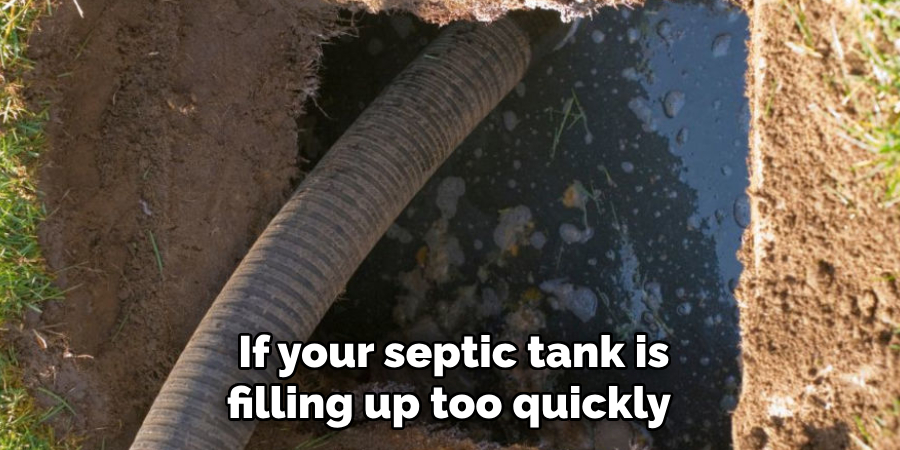
- If your septic tank is filling up too quickly, try reducing the amount of water usage in your household. This includes fixing any leaky pipes or faucets, using low-flow fixtures, and avoiding excessive use of dishwashers and washing machines.
- Regular maintenance is key to preventing costly repairs or replacements for your septic tank. Make sure to schedule regular inspections and pumping every 3-5 years, depending on the tank size and household usage.
- Avoid flushing items that are not biodegradable or can clog your septic system, such as paper towels, wipes, feminine hygiene products, and cigarette butts. These items can cause blockages and damage to your system.
- Suppose you notice any issues with your septic tank, such as slow-draining sinks or toilets, foul odors, or standing water in your drain field. In that case, it is important to address them immediately before they escalate into bigger problems.
- Consider installing a filter on your washing machine to prevent lint and debris from entering your septic system. This can help extend the lifespan of your septic tank and reduce the need for frequent pumping.
- Be cautious when planting trees or shrubs near your septic system, as their roots can grow into the pipes and cause damage. Consult with a professional before landscaping in your drainfield area.
- Use safe, environmentally-friendly cleaning products that are septic tank-friendly. Harsh chemicals and antibacterial soaps can kill beneficial bacteria in your septic system, hindering its ability to break down waste effectively.
- As a precaution, keep a record of your septic tank maintenance and repairs for future reference. This can help you track any patterns or issues that may arise over time.
- Educate yourself and your household members about proper septic tank use and maintenance to avoid any mishaps or costly repairs. Know the location of your septic tank, drain field, and access points in case of an emergency.
- Lastly, consult a professional septic tank service provider if you need clarification on any aspect of your septic system or need assistance with maintenance or repairs. They have the expertise and equipment to properly maintain and repair your septic system.
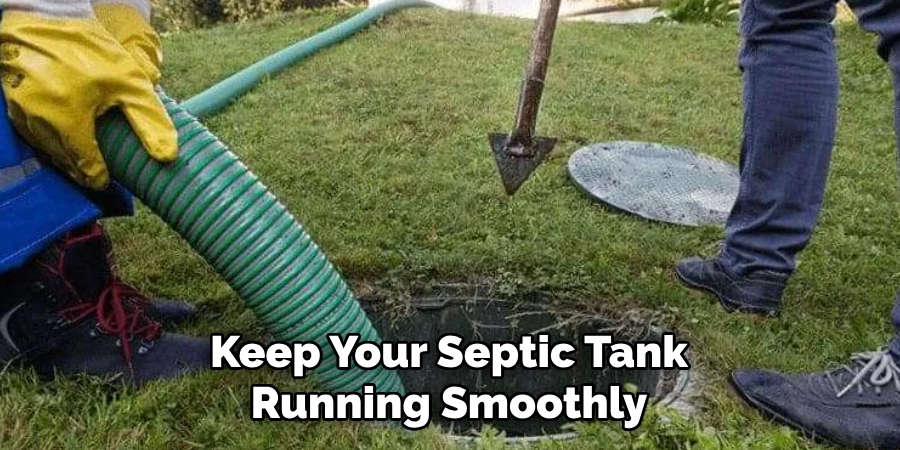
Following these tips and tricks can help keep your septic tank running smoothly and avoid any potential problems. Proper maintenance and responsible usage of your septic system will save you money and protect the environment.
Remember to schedule regular inspections and pumping, avoid flushing non-biodegradable items, use environmentally-friendly products, and educate yourself about proper septic tank care. With these practices in place, you can ensure the longevity and effectiveness of your septic system. So don’t wait; start implementing these tips today to pump your septic tank efficiently!
Things You Should Consider to Pump Septic Tank
- The first thing you should consider when pumping your septic tank is the frequency at which it needs to be done. It is recommended to have your tank pumped every 3-5 years, depending on your household size and the amount of waste generated.
- Another important factor to consider is the location of your septic tank and its accessibility for pumping. If your tank is buried too deep or located in a difficult-to-reach area, it may be more challenging and costly to pump.
- Hiring a professional septic tank pumping company for this task is crucial. Attempting to pump the tank yourself can be dangerous and lead to further damage if not done correctly. Professionals have the necessary equipment and knowledge to properly pump and dispose of the waste.
- It is essential to inform the pumping company of any potential issues or concerns with your septic system, such as leaks, blockages, or unusual odors. This will help them assess and address any problems before pumping.
- Before the pumping process begins, make sure to locate and uncover all the access points to your septic tank. This includes locating and removing any covers, lids, or risers. This will save time and allow for a thorough pumping.
- During the pumping process, keeping an eye on the waste being removed from your tank is important. If there are excessive amounts of solids, this may indicate a problem with your septic system that needs to be addressed.
- After the tank has been pumped, it is advisable to have the pumping company inspect and clean the inlet and outlet pipes. This will ensure that the pipes are clear of any blockages or debris, allowing for proper flow.
- Adding a bacterial additive to your septic system after it has been pumped is also recommended. These additives help break down solids in your tank, reducing the need for frequent pumping.
- Regular maintenance and care of your septic system is crucial to its longevity and functionality. This includes proper use of water, avoiding flushing non-biodegradable items, and regular inspections by a professional.
- Lastly, keeping records of when your tank was pumped and any maintenance or repairs done to your septic system is important. This will help you determine when the next pumping is needed and identify any recurring issues that may need to be addressed.
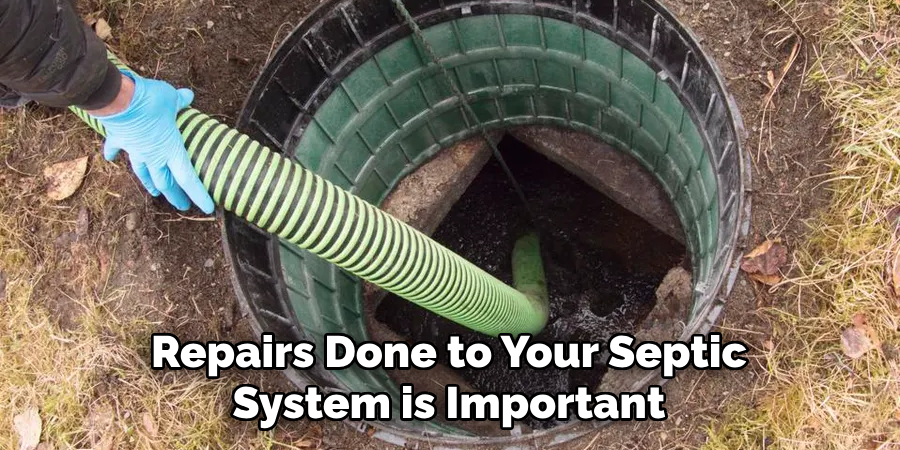
Following these considerations will help ensure a successful and efficient septic tank pumping process, saving you time and money in the long run. Always consult a professional for any concerns or issues with your septic system.
Proper care and maintenance allow your septic tank to last many years without major problems. So, staying informed and taking necessary precautions is important to keep your septic system running smoothly. So, always stay educated about the do’s and don’ts for proper septic tank maintenance.
Tips for Maintaining a Healthy Septic System
1. Regular Pumping:
Pumping your septic tank regularly is crucial to its proper functioning. Over time, solid waste accumulates in the tank and can cause clogging or blockages in the system. The frequency of pumping depends on several factors, such as household size, wastewater volume, and the size of your septic tank. Generally, it is recommended to have your septic tank pumped every 3-5 years.
2. Conserve Water:
Excessive water usage can put a strain on your septic system, leading to overflows or backups. Be mindful of your water usage and try to conserve water whenever possible. This includes fixing leaky faucets or toilets, using water-efficient appliances, and spreading out laundry loads throughout the week instead of doing them all at once.
3. Avoid Flushing Harmful Substances:
Your septic system is not designed to handle certain substances, such as grease, oil, chemicals, and non-biodegradable items like paper towels and feminine hygiene products. Flushing these items can clog the pipes and cause damage to your septic system. Dispose of these substances properly instead. This includes using a grease trap for cooking oil and disposing of hazardous chemicals at designated facilities.
4. Use Septic-Safe Products:
Some household products contain harsh chemicals that can disrupt the natural balance of bacteria in your septic tank, making it less effective in breaking down waste.
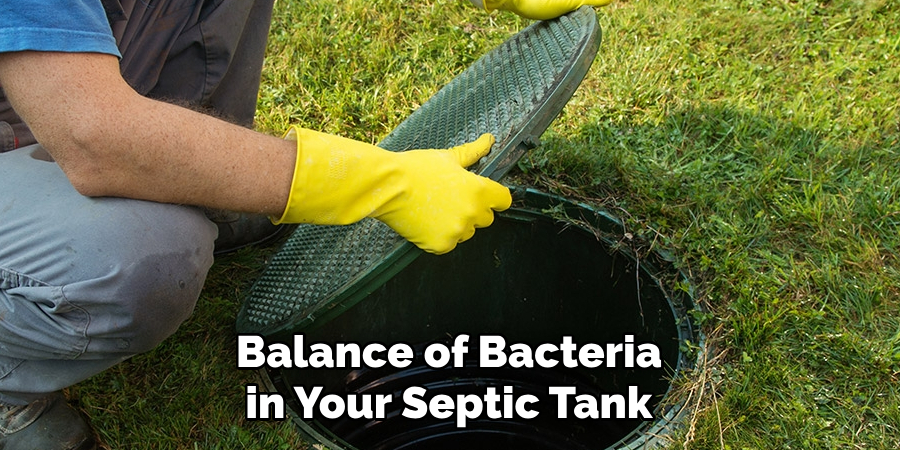
Choose septic-safe cleaning and personal care products that are biodegradable and free from harmful chemicals. You can also use alternative cleaning methods, such as vinegar and baking soda, to reduce the use of harsh products.
5. Protect Your Septic System:
Avoid driving or parking heavy vehicles on your septic system’s drain field, as this can cause damage to the pipes and compact the soil. Also, be careful not to plant trees or shrubs near the drain field, as their roots can penetrate the pipes and cause blockages. Keeping the area around your septic system clear and free from potential hazards is essential.
6. Regular Inspections:
Even if your septic system appears to be functioning properly, it’s crucial to have it inspected regularly by a professional. They can catch any potential issues before they become major problems and ensure that your septic system is in good working condition. Regular inspections can also help extend the lifespan of your septic system, saving you money in the long run.
7. Educate Your Household:
Proper septic system maintenance requires cooperation from all members of the household. Ensure everyone knows what they can and cannot flush down the toilet or put down the drain. Educate them about the importance of conserving water and using septic-safe products. By working together, you can help maintain a healthy septic system for years to come.
Following these tips can help you maintain a healthy septic system and avoid costly repairs or replacements. Remember to stay informed about your septic system’s needs and address any issues promptly.
With proper care, your septic system can last for decades, providing efficient wastewater treatment for your household. So, make sure to follow these guidelines and keep your septic system functioning at its best. Happy septic tank, happy home!
Frequently Asked Questions
What is a Septic Tank?

A septic tank is an underground chamber made of concrete, fiberglass, or plastic that collects and treats wastewater from household plumbing. It is commonly used in areas without access to a centralized sewage system.
How Often Should I Pump My Septic Tank?
The frequency of septic tank pumping depends on the size of your tank and the number of people living in your household. Typically, a septic tank should be pumped every 3-5 years for a family of four. However, if you have a larger tank or fewer occupants, it may only need to be pumped every 5-8 years.
Why is Pumping My Septic Tank Important?
Regular septic tank pumping helps prevent the buildup of scum and sludge, which can clog the system and cause costly repairs. It also helps maintain a healthy balance of bacteria in the tank, aiding in the breakdown of solid waste.
How Do I Know When My Septic Tank Needs to be Pumped?
A few signs may indicate it’s time to pump your septic tank. These include slow draining or gurgling drains, foul odors in and around your home, and the presence of wet areas or lush patches in your yard near the septic tank.
Can I Pump My Septic Tank Myself?
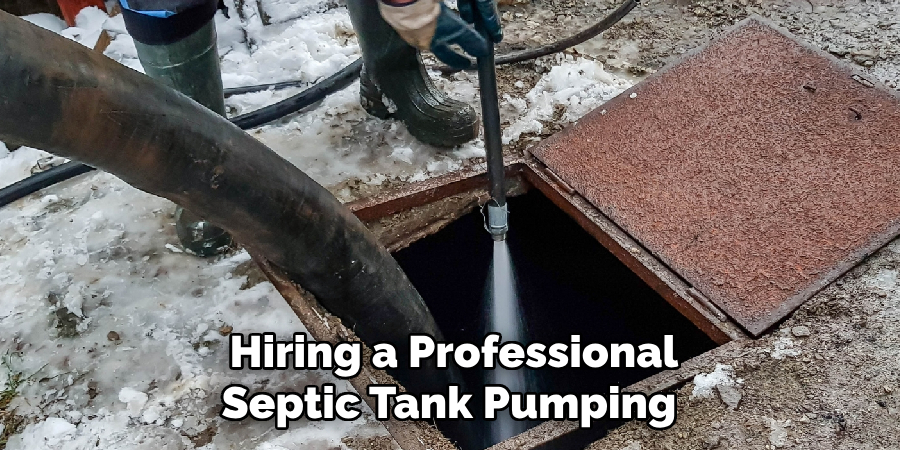
It is not recommended to pump your own septic tank as it requires proper training, equipment, and disposal methods. Hiring a professional septic tank pumping service is best to ensure the job is done correctly and safely.
Conclusion
Now you know how to pump septic tank and why it’s important to do so regularly. By understanding the basics of septic tank maintenance, you can prevent costly repairs and maintain a healthy and functioning system.
Remember to keep track of your pumping schedule based on the size of your tank and household, and always hire a professional for the job. If you have any other questions or concerns about your septic tank, don’t hesitate to consult a professional for guidance. Happy pumping!

